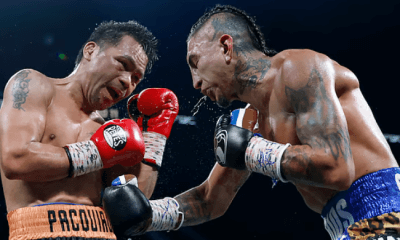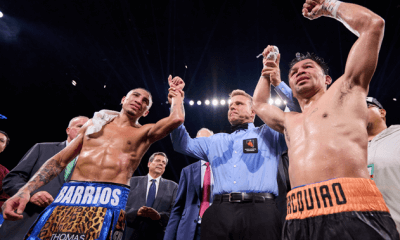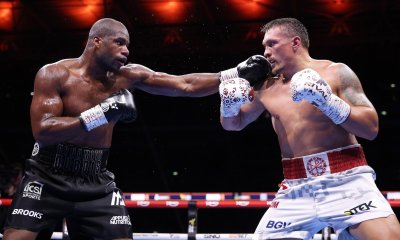Articles of 2007
Jorge Linares: The Next Alexis Arguello?
For some boxing followers the name Alexis Arguello means nothing more than a footnote in the back pages of a boxing almanac, but for those who saw the gallant Nicaraguan boxer with a punch that could stop a subway train, he was the ultimate professional boxer.
After more than a decade of full retirement Arguello remains one of the icons of Latino boxers. A man who not only represented his native Nicaragua, but every poor barrio in South America, Central America and North America.
Arguello epitomizes class.
His fights with Aaron Pryor are two of the greatest ever held and gripped the boxing world with not only their fistic prowess, but their near-death experiences that followed.
People care about Pryor and Arguello even to this day.
So can anyone truly fill Arguello’s shoes?
“I think Jorge Linares is the next Arguello,” said Tony Rivera, a boxing expert of the highest order.
Rivera has worked the corners of Marco Antonio Barrera, Robert “Manos de Piedra” Duran and also the great Nicaraguan himself Arguello. He’s participated in the corners of some of the greatest fights ever held and knows what constitutes greatness.
“I’m being honest when I say I think he has the tools to be as great as Arguello,” says Rivera who continues to work the corners of some of the world’s best fighters including Linares and Edwin Valero.
WBA featherweight titleholder Linares (24-0, 15 KOs) meets Mexico’s street-tough and ring experienced Gamaliel Diaz (22-6-2, 9 KOs) on Saturday Dec. 15, at the Plaza del Toros in Cancun, Mexico. The fight card will be available on pay-per-view television.
Linares carries himself with a quiet dignity and shows above average patience when others interrupt him or tap him from behind. And when he enters a boxing ring he looks and moves gracefully like a flamenco dancer.
The Venezuelan boxer does not look or act like the prizefighter who walloped former world champion Oscar Larios in front of thousands in Las Vegas earlier in the year.
“When he beat Larios he beat a real warrior,” said Rivera who was present at the fight. “Linares hits what he aims at. If you can land a four-punch combination that’s a beautiful thing.”
Rivera and others also like the accuracy of his punches, the speed of his feet and combinations and the power behind those fists.
“He’s very quick,” said Rudy Hernandez who has trained numerous fighters and world champions.
Though already owner of a world title, Linares seems more like a hungry young fighter eager to rise to the top.
“I’m even more prepared for this fight than I was against Oscar Larios,” Linares, 22 said while at a Japanese restaurant in Little Tokyo in downtown Los Angeles. “I think I have some more things to show in this next fight.”
It could be an easy test or it could be one of those clashes that serve as a gut check. When you fight a Mexican fighter on his home turf he’s not in there to exchange flowers.
IBF featherweight titleholder Robert “The Ghost” Guerrero needed two fights to decipher Diaz’s roughhouse style. The gaunt-looking Diaz fights with elbows and shoulders and doesn’t seem to follow rules in the ring. He just fights.
Linares is ever the gentleman.
“I don’t know much about who I’m going to fight I just prepare to fight against anybody,” said Linares who has lived in Japan the last five years and speaks Japanese. “It’s a good experience for me living in Japan. It’s difficult to have my family living so far from me, but it’s a sacrifice I’m willing to do.”
Teiken, who are co-promoting the fight, have flown him into Los Angeles in the past to spar with veterans and world champions such as Manny Pacquiao, Marco Antonio Barrera and Israel Vazquez.
It was these sparring sessions that convinced Teiken that it was time for the young Venezuelan to test his skills against the best in the world. He passed.
“Believe me he’s got all the tools,” said Tony Rivera, who remains one of the more requested corner men in the business. “He’s a five tool fighter he’s got speed, power, height, stamina and most importantly he hits what he’s aiming at.”
With all of the problems going on in his native country, Linares has that cool air about him in discussing Venezuela.
“Things are very complicated in Venezuela right now,” Linares said. “It’s nice being in Japan. I’ve learned many things and the culture is very enlightening.”
On Saturday the Venezuelan hopes to enlighten the world with his boxing talent.
“There’s not a guy out there that has the tools to beat this kid,” said Rivera. “At least not at featherweight.”
Maybe somewhere Arguello is smiling.
Other bouts
Japan’s Naoki Matsuda plans to repeat his performance of last March when he survived a first round knockdown from former featherweight world titleholder Rudy Lopez (20-4-1, 14 KOs) and fired a single right hand to knock out the Mexican fighter.
“He has a picture perfect right hand,” said Nobu Ikushima, coordinator for the promotion company Teiken. “It’s not a surprise he won. He’s undefeated in his last 14 fights.”
Matsuda says he’s preparing in the same manner to repeat the same results.
“Everything is the same in my training,” said Matsuda (28-7-3, 11 KOs) who lives and trains in Tokyo. “I hope I can defeat Rudy Lopez again. Then I want to fight for a world title.”
On two other bouts the sons of former boxing greats will be featured including Pipino Cuevas Jr. (12-1, 10 KOs) in a lightweight bout and Wilfredo Vazquez Jr. (8-0, 7 KOs) in a featherweight bout.
Fights on television
Fri. Telefutura, 8 p.m., Miguel Angel Huerta (25-8-1) vs. Daniel Alicea (30-6-2).
Sat. pay-per-view, 6 p.m., Edwin Valero (22-0) vs. Zaid Zavaleta (15-2-3); Jorge Linares (24-0) vs. Gamaliel Diaz (22-6-2); Rudy Lopez (19-4-1) vs. Naoki Matsuda (28-7-3);
-

 Featured Articles3 weeks ago
Featured Articles3 weeks agoThe Hauser Report: Zayas-Garcia, Pacquiao, Usyk, and the NYSAC
-

 Featured Articles2 weeks ago
Featured Articles2 weeks agoOscar Duarte and Regis Prograis Prevail on an Action-Packed Fight Card in Chicago
-

 Featured Articles1 week ago
Featured Articles1 week agoThe Hauser Report: Cinematic and Literary Notes
-

 Book Review4 days ago
Book Review4 days agoMark Kriegel’s New Book About Mike Tyson is a Must-Read
-

 Featured Articles4 weeks ago
Featured Articles4 weeks agoManny Pacquiao and Mario Barrios Fight to a Draw; Fundora stops Tim Tszyu
-

 Featured Articles4 weeks ago
Featured Articles4 weeks agoArne’s Almanac: Pacquiao-Barrios Redux
-

 Featured Articles3 weeks ago
Featured Articles3 weeks agoRemembering Dwight Muhammad Qawi (1953-2025) and his Triumphant Return to Prison
-

 Featured Articles4 weeks ago
Featured Articles4 weeks agoOleksandr Usyk Continues to Amaze; KOs Daniel Dubois in 5 One-Sided Rounds













